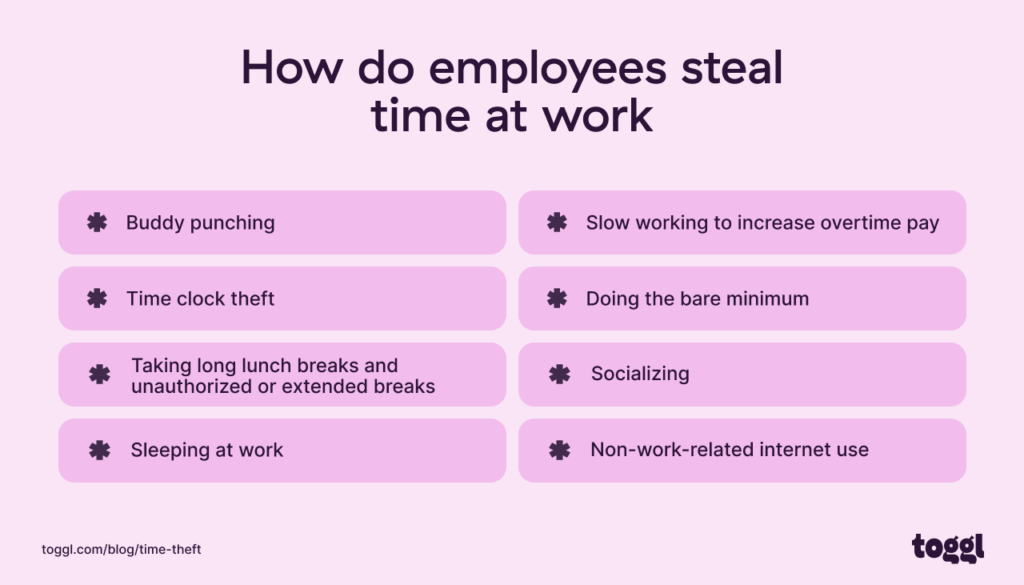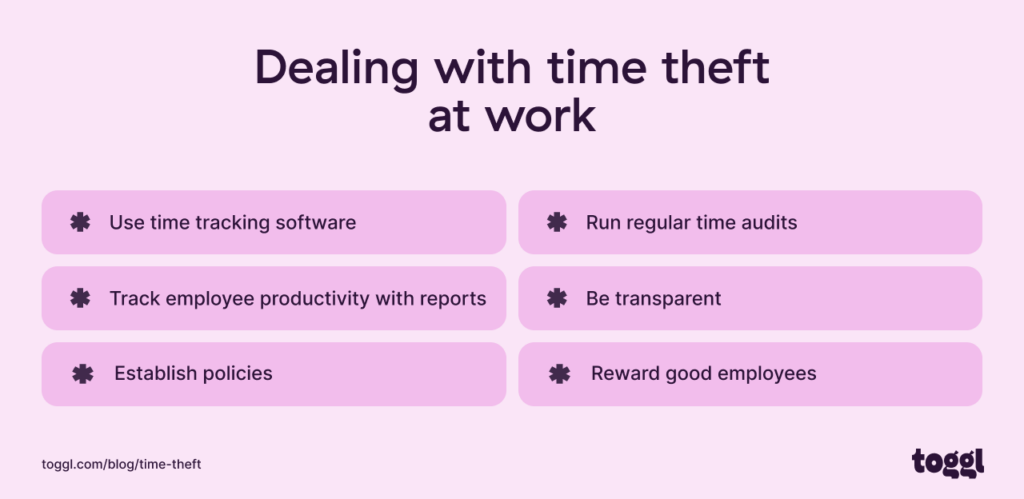Time theft happens when employees are paid for the time they haven’t spent working. While it might not seem like a big deal, time theft can add up quickly and impact your bottom line.
Are you losing hours and dollars to time theft without even knowing it?
It can happen in many ways — unintentional harmless activities such as browsing social media or blatantly fraudulent ones such as padded timesheets.
It’s frustrating, right? But there are ways to stop it.
In this article, we dive deep into the what, why, and how of time theft. Let’s start by understanding what time theft is and what it isn’t.
What is time theft?
Time theft is a serious but often ignored workplace problem that happens when employees are paid for the hours they didn’t work.
It occurs when an employee is supposed to be at work or on the clock but isn’t working. It also includes simply avoiding duties and responsibilities, purposefully working slowly, and time fraud.
According to QuickBooks, US employers lose $11 billion annually to time theft.
There are different types of time theft. These include:
- Buddy punching
- Time clock theft
- Taking long lunch breaks and unauthorized or extended breaks
- Sleeping at work
- Slow working to increase overtime pay
- Doing the bare minimum
- Socializing
- Non-work-related internet use
Unsure how some of these methods contribute to time theft? Let’s look at some examples 👇
Examples of time theft
An example of time theft is employees who goof off at work and spend time chatting with colleagues instead of getting work done. They’re still paid for the hours but complete minimal—if any—work.
Another example of stealing time in the workplace is time entry padding, where employees round up their time entries to make it appear they worked more hours than they did.
We’ll explore how employees steal time in more detail later in this article. First, let’s consider the consequences.
Consequences of time theft in the workplace
Time theft affects both employers and employees in different ways.
Time theft consequences for employers
- Toxic work environment: Time theft harms honest employees who work productively. They may become annoyed, frustrated, and demotivated when others exploit the system.
- Employee morale is hurt: Following the previous point, employees who see coworkers get away with time theft can decrease morale, enjoyment, and satisfaction in their work. This can increase the turnover rate and make it hard to retain good workers.
- Lower employee productivity levels: If employees participate in time theft practices, they aren’t committing or contributing fully to the role and company. This reduces overall company productivity as projects get delayed.
- Financial loss: Employers suffer direct financial losses from employee time theft as employees are paid for hours they didn’t work, increasing labor costs. A few extra minutes don’t seem like a lot, but it can add up over time and significantly impact profitability and the bottom line.
Time theft consequences for employees
- Worsened job security: Time theft may lead to poor performance reviews as the amount of completed work doesn’t align with the hours worked. This puts job security at risk as underperforming employees will be first in line for dismissal.
- Loss of trust: An employee caught engaging in time theft will lose the trust of their supervisors, managers, and colleagues. It’s difficult to win back trust, so it could impact the work environment once it’s gone.
- Damaged reputation: Time theft is bad for reputation as employees look unprofessional and untrustworthy. This perception could halt career advancement and ruin prospects for promotions.
Is time theft illegal?
Time theft is not typically classified as a crime under US federal law, even though it is fraudulent and technically stealing. Generally speaking, it’s up to the employer to decide how they want to deal with it.
However, depending on company policies, employment contracts, and their regulations and requirements, time theft can be considered a breach of contract. If so, employees could be liable for disciplinary action, employment termination, or legal action.
On the other hand, it is a legal requirement under the Fair Labor Standards Act for employees to be paid for their time, so you can’t withhold wages (wage theft) even if you suspect an employee of time theft.
It is difficult to prove time theft without technology, so most employers ignore this problem.
Employee time theft punishment
The extent to which an employee can be penalized for time theft depends on local labor laws and the severity of the infraction.
For example, in Canada, non-unionized employees can be punished for committing time theft by making them work in the office instead of remotely, put on unpaid leave, or terminated.
Other potential punishments for employee time theft include:
- Verbal warning, in a 1:1 meeting.
- Written warning that outlines escalation of disciplinary action if the behavior continues
- Loss of privileges like restricting access to benefits
- Paid or unpaid leave
- Employment termination
- Lawsuit
If you can prove an employee has committed time theft worthy of punishment, consult an expert in local, state, and federal labor and employment laws to ensure you remain compliant.
Ensure the punishment fits the severity of the time theft, and don’t assume the employee acted maliciously if it is their first offence.
Types of time theft
Employees can commit time theft in several ways.

Let’s look at each of them in detail.
1. Buddy punching
Buddy punching is when an employee sees a colleague is late and uses the colleague’s employee code or swipe card to clock in for them, even though they aren’t at work yet. It can also be used to clock out employees after they’ve left.
Many time tracking systems are susceptible to buddy punching as clock-in codes or cards can easily be shared between coworkers.
2. Time clock theft
Time clock theft is adjusting a timesheet to falsely inflate the hours worked.
Handwritten timesheets can be easily padded to add more minutes or hours, and time clocks can be abused to pad time entries. If your company operates a time rounding system, employees could clock in five minutes late and out five minutes early every day and still be paid for a full shift.
3. Taking long lunch breaks and unauthorized or extended breaks
Long lunches and unauthorized breaks are methods of time theft that contribute considerably to decreased productivity and harm employee morale.
Employees may take their time returning to their desks to give themselves longer breaks, leave their desks outside of break time for no reason, or sneak out for multiple smoke breaks during their workday.
4. Sleeping at work
According to a study by WebMD, the average American sleeps 5.7 hours a night, far less than the recommended eight hours.
For new parents and chronic illness sufferers, it could be even less
Some people make up for the lack of sleep by napping during break time. When this spills over into work time, it’s time theft.
5. Slow working to increase overtime pay
Working as slowly as possible is another form of time theft. When hourly-wage workers find a job easy, they may slow down and take extra time completing their tasks to log more hours and receive more pay.
Employees could work slowly to increase the likelihood of a job being unfinished by the end of the day, hoping that overtime pay will be authorized.
6. Doing the bare minimum
Similar to the previous method, employees can commit time theft by doing as little as possible during some of their work hours while making sure their time card reflects a full work day.
This could also signify a more serious issue — quiet quitting.
7. Socializing
Non-work socializing, such as taking personal calls (without permission) or accessing social media apps on a smartphone when on the clock, is a type of time theft that can be a big problem if clear policies preventing it aren’t outlined.
However, employee socializing is not always a bad thing. When done right, it can contribute to a happier, more productive work environment, so don’t jump to squash any socializing on company time.
Excessive socializing that inhibits delivering work on time verges on time theft, so ensure company policies outline how much employee socializing is acceptable.
8. Non-work-related internet use
Employees steal time by using the internet for non-work-related, personal tasks like shopping online, reading the news, or other things that should be done on personal time.
This method gives the appearance of being busy and can trick employee monitoring software that monitors computer activity.
Why do employees steal time at work?
Employees resort to time theft in the workplace for various reasons. Some of the key reasons employees steal time are listed below:
- Low morale: If employees feel disconnected from their work due to unfulfilling duties, poor management practices, a hostile or toxic work environment, or a lack of recognition, they’re more likely to commit time theft as they don’t care as much about the job.
- Perceived injustice: Employees who feel they are unfairly treated or compensated could engage in time theft as a form of compensation. They could feel injustice because of unacknowledged work, workplace favoritism, pay disparities, or a lack of advancement opportunities.
- Improper training: Failing to train employees properly beyond their primary tasks could result in time theft. Employees who feel they have nothing else to do fill the time with personal tasks to appear busy.
- Stress and burnout: When employees are under a lot of stress or suffer from burnout, they may participate in time theft practices to cope.
- Peer influence: If time theft is a pervasive problem in your company that goes unpunished, new employees will likely feel it is acceptable and partake in the practice, too.
In the next section, we’ll look at how to prevent time theft in the workplace.
How to prevent time theft in the workplace
Thankfully, there are several methods you can employ to prevent time theft.

Let’s deep dive into each method and see how you can implement it. 👇
1. Use time tracking software
Time tracking software is a tool that accurately tracks employee work hours and inputs them into a timesheet.
Timekeeping software can help business owners prevent or minimize time theft because it monitors employees’ time on specific tasks and projects, making it harder to falsify time records.
Time tracking and attendance software gathers real-time data about employee time and uses it to create reports that help managers address discrepancies, promote honesty and accountability, and discourage time theft.
Toggl Track has automatic time tracking features that let employees privately track their time and activity from the desktop app. Employees can choose the time entries to report, bringing accountability without excessive monitoring.
The tool also has a start/stop timer mode. Users simply click the timer, and it records their time accurately.

2. Create a timesheet approval process
Managers should review employee timesheets and set up an approval process to look for time discrepancies, such as hours that don’t match the schedule and excessive overtime.
While these inconsistencies aren’t necessarily proof of time theft, the timesheet can be rejected with information provided to the employee on what to change for a timesheet approval. This process helps to address potential time theft before it gets to payroll.
Toggl Track has a simple timesheet approval workflow. Employees submit timesheets for approval to the relevant manager or supervisor.
If a timesheet is rejected, the approver can add a comment detailing the errors they spotted so the employee can address them.

3. Track employee productivity with reports
Getting reports on time spent on tasks can help provide valuable insights into how and where employee time is spent.
Toggl Track’s Summary report shows the total tracked time broken down by user or team, client, project, task, billable/non-billable, and more. The Detailed report shows every time entry within the chosen date range.
Access to this information helps managers measure employee productivity and see how many tasks each employee completes in a given period. This, in turn, helps identify and curb instances of time theft.
4. Establish clear policies
Establishing clear policies for acceptable work practices and disciplinary actions is the cornerstone of time theft prevention.
Ensure you set out rules against buddy punching and time entry padding in a time theft policy and outline the consequences of committing these acts.
Outline policies regarding appropriate computer, smartphone, and internet use during work hours and ensure everyone is on the same page regarding employee socializing.
5. Run regular time audits
A time audit is an in-depth review of work hours spent. It is a good tool for identifying time theft and other problems, as it can spot activities that regularly take a lot of time and other discrepancies.
Toggl Track’s Time Audit feature lets you audit the time entries in your workspace through the Summary or Detailed reports. You can look for time entries that have no project or no task assigned to them or entries that are unusually long or short.
6. Be transparent
A transparent workplace can reduce time theft because employees who are engaged, satisfied, and happy in their jobs have less desire for time theft.
7. Reward employees
Rewarding good employees can help deal with time theft by incentivizing good behavior and hard work. It helps to boost morale and give recognition to high achievers.
This can help prevent feelings of injustice that damage morale.
Conclusion
Time theft is a major problem for businesses, and if not strictly managed, it can severely impact profits and labor costs.
Implementing preventative measures, such as clear time theft policies, transparency, and using advanced time tracking software with reports and time audit features, helps prevent time theft.
Toggl Track lets users monitor time spent on projects and tasks, preventing time theft and helping managers increase employee productivity. Sign up for Toggl Track for free, which helps prevent time theft at your business today.
Work tools to elevate your productivity – apps for incredibly simple time tracking and effective project planning.

